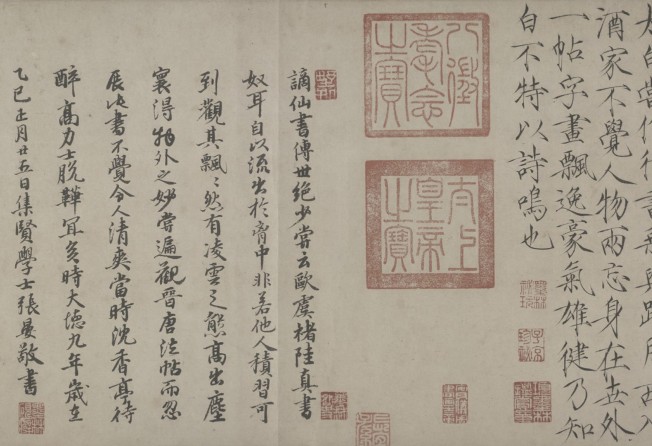
Just Stop Oil climate activists’ art attacks can’t compare to China’s worst ever art vandal
- The Emperor Qianlong defaced countless priceless Chinese artworks with his own seals, acts of vandalism far above those of climate activists’ recent attacks
- That Qianlong didn’t think what he did was vandalism just makes it that much more infuriating

In a series of strikes, climate activists attacked important artworks in three museums in October.
On October 14, two young people from Just Stop Oil threw tomato soup at one of Van Gogh’s sunflower paintings in the National Gallery in London, England.
On October 23, two activists associated with the German group Letzte Generation slung mashed potatoes at a Monet painting in the Museum Barberini in Potsdam, Germany.
On October 28, another pair of Just Stop Oil activists attacked Vermeer’s Girl With a Pearl Earring, with one gluing his own head to the glass covering the painting and the other pouring tomato soup over him.

None of the paintings were damaged as they were protected by glass, but many people, including those who support environmental causes, have questioned if the actions were justifiable and wise.
Instead of their avowed enemies such as fossil fuel corporations and other polluting businesses, why did the activists target museums, which are often non-profit concerns that benefit the public? Will their ill-advised acts turn people against them, or even worse, the environmental movement in general?
Arguably, the worst art vandal in China was the Emperor Qianlong, who reigned from 1735 to 1796. He presided over a prosperous and powerful empire built on the foundations laid by his grandfather and father, and the Qianlong period marked the zenith of the Qing dynasty.
An erudite man who received an excellent education, Qianlong fancied himself a connoisseur and maker of art. He possessed a huge collection of Chinese paintings, calligraphic works and antiques, on which he often expressed himself artistically.
He would affix his personal seals – it is said he had over a thousand of them – on the artworks, often accompanied by an exposition written in his own hand about the work or the effect it had on him.
This was by no means exceptional, as it was a common and accepted practice among Chinese art collectors in the past. Qianlong, however, took it to a completely new level.

Defacement is the only word that can describe what Qianlong did to some of the most precious Chinese works of art.
Going Up to Sun Terrace may well be the only surviving copy of the handwriting of Li Bai (AD701-762), the Tang dynasty poet who died almost 950 years before Qianlong was born. On this calligraphic scroll, Qianlong stamped dozens of seals.
Dwelling in the Fuchun Mountains, by Huang Gongwang (1269-1354), is considered one of the greatest Chinese landscapes. Qianlong had two versions. On the “Ziming Scroll”, which he believed to be the product of Huang’s own hand, he filled all the blank spaces, an important artistic feature of traditional Chinese paintings, with his own writing and seals.
As luck would have it, modern art historians have identified the other version as genuine, to which Qianlong did less damage.
There are many other examples.
We can only speculate what drove Qianlong to vandalise these artworks – a desperate need for validation, perhaps, maybe even an obsessive-compulsive personality. Or maybe he was just a jumped-up vulgarian with nobody to tell him off.
The paintings of van Gogh, Monet and Vermeer escaped damage, but Qianlong’s vandalism of priceless artworks permanently defaced them. That Qianlong didn’t think what he did was vandalism just makes it that much more infuriating.